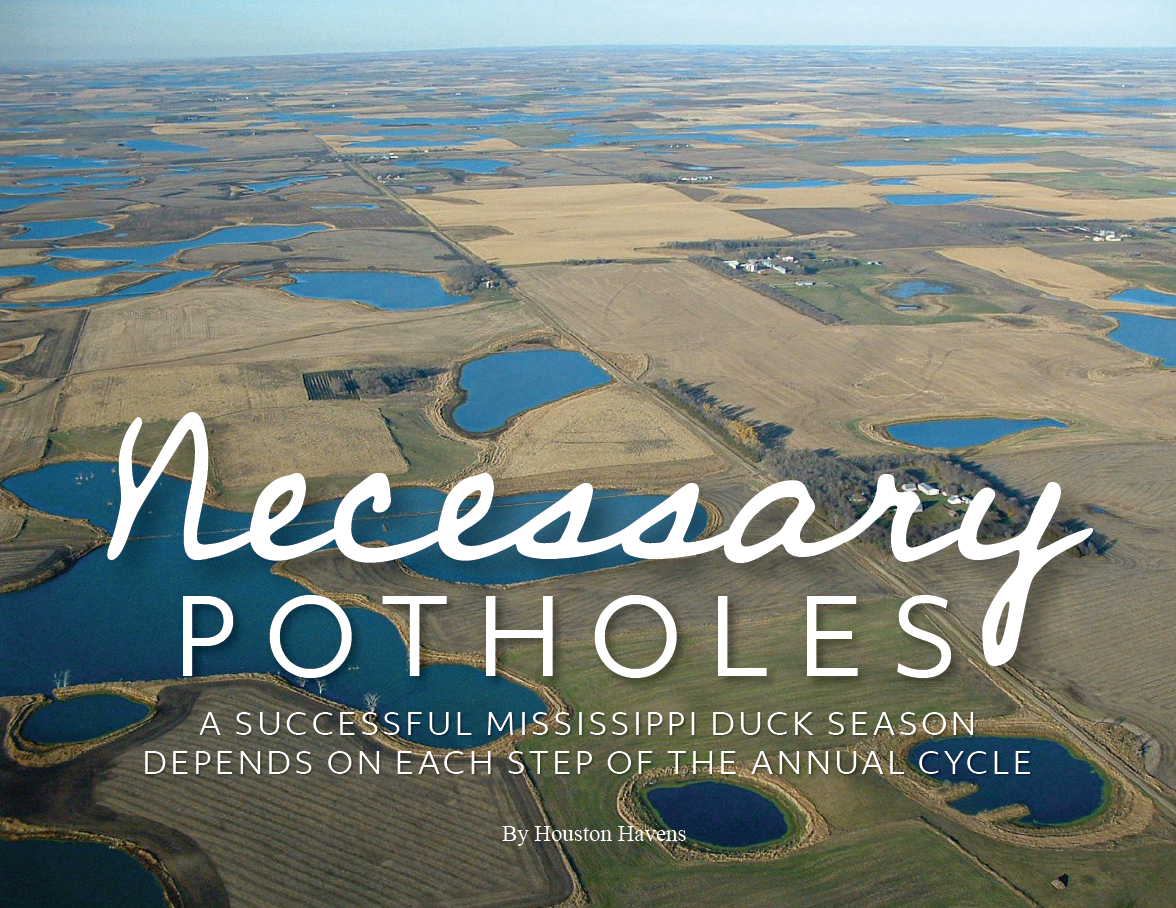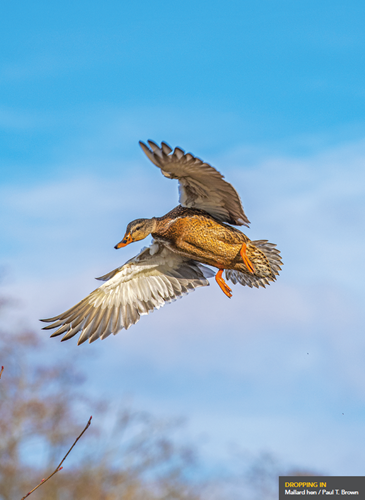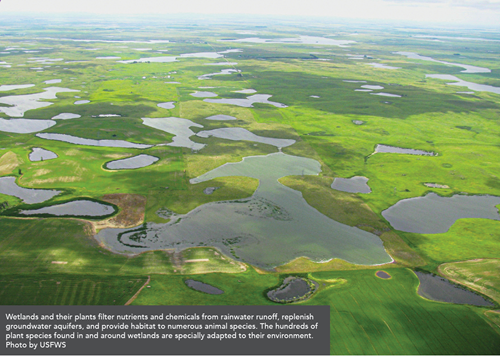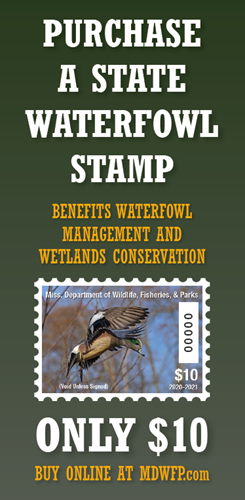Necessary Potholes: A successful Mississippi duck season depends on each step of the annual cycle
11/16/2020 10:45:29 AM
By Houston Havens

Prairie potholes once surrounded by nothing but grass are now part of agricultural fields, homesteads, shelterbelts, and roads. Waterfowl Production Areas and easements preserve habitat in a very fragmented landscape. Photo by Laura Hubers / USFWS
Ducks and geese have begun arriving to spend another winter in Mississippi, and duck hunters are looking to the skies with high expectations. For many Mississippi duck hunters, preparations for this hunting season began back in the spring with wetland habitat planning and management, with the ultimate goal of attracting waterfowl during their southern migration this fall and winter.
Since “setting the table” with quality wetland habitat is the primary factor under control here on the wintering grounds, the importance of waterfowl breeding habitat is often considered out of our control or not our responsibility. However, migratory birds, such as waterfowl, are a continentally managed, shared natural resource. Therefore, conservation efforts are focused on the large-scale geographies used as the birds progress through their complex annual cycles.
Year-round responsibility
Each portion of the annual cycle is vital for maintaining high duck numbers: nesting, brood-rearing, migration, surviving winter, and so on. But a wealth of scientific evidence shows that the quantity and quality of nesting habitat are the most important factors that drive duck populations. Quality waterfowl habitat on the breeding grounds includes large numbers of wetlands as well as large areas of grassland nesting cover. These habitats are found throughout the Prairie Pothole Region of North and South Dakota and the Canadian provinces of Manitoba, Saskatchewan, and Alberta. Breeding waterfowl are attracted to regions with an abundance of wetlands peppering the landscape (hence the name “potholes”).
Some of the highest densities of wetlands in North America occur in the Missouri Coteau region of North and South Dakota. This region, located along the Missouri River, contains high numbers of pothole wetlands surrounded by great expanses of grasslands. Waterfowl breeding pairs set up territories on these wetlands and later begin nesting in the local area. Many people think that all ducks nest at or near the water’s edge, and in some cases that is true, particularly where wetlands only have a narrow buffer of grass or cattails surrounding potholes. However, most successful hens nest in upland grasslands with dense cover, sometimes up to a mile away from the nearest wetland.

Contrary to popular belief, Mississippi and other Southeastern states do not produce a large number of ducks. Certainly, there are strong resident populations of cavity-nesting species, like wood ducks and hooded mergansers. Plus, there are places across the state where mallards and other species can be found during the summer, though most of these birds likely come from a domestic lineage.
But the overwhelming majority of ducks seen buzzing over decoys and harvested by Mississippi hunters migrate from other areas. Because some of the ducks’ more critical times are spent in other regions, it makes sense that Mississippi hunters would also contribute to waterfowl conservation where the ducks’ most critical needs occur. And the good news is, they are.
Mississippi’s role
Mississippi is fortunate to have a state migratory waterfowl stamp, also known as the state duck stamp, which is required for all waterfowl hunters in the state who are 16 and older. A state statute directs revenue generated from the sale of this stamp to protect and propagate migratory waterfowl and to develop, restore, maintain, and preserve wetlands. In recent years, Mississippi has averaged around 38,000 state waterfowl stamps sold to residents and non-residents. In any given year, opportunities to spend waterfowl stamp revenue often exceed the amount of funding available, so projects must be prioritized to maximize the benefits of these limited dollars.
Mississippi Department of Wildlife, Fisheries, and Parks (MDWFP) takes a “diversified portfolio” approach in using stamp funds by first considering wetland and waterfowl needs within the state. Just in the past few years, state waterfowl stamp revenue has been used for the following:
- Matching other funds to acquire or enhance Wildlife Management Areas (WMAs) for waterfowl management and public hunting;
- Supporting a Mississippi private land wetland assistance program;
- Supporting waterfowl research projects with Mississippi State University;
- Pumping water into waterfowl impoundments on some WMAs;
- Contributing to the North American Wetlands Conservation Act grants to restore or develop additional public land waterfowl habitat and management capability.
MDWFP also provides a portion of state waterfowl stamp funds each year to partner organizations, such as Delta Waterfowl and Ducks Unlimited, for waterfowl conservation work on the breeding grounds. Some of these projects target wetland and grassland protection by placing conservation easements on properties in important nesting and brood-rearing areas across the Canadian prairie. Others focus on working with private landowners in key habitat areas to develop better land management and farming practices to integrate waterfowl conservation with working lands. In turn, these partner organizations use Mississippi dollars to leverage other sources of funding, stretching the conservation impact even further.

As a member of the Mississippi Flyway Council, MDWFP participates in cooperatively funded banding and waterfowl monitoring projects on the breeding grounds. Several of these projects band ducks throughout the breeding grounds during late summer, which provides insight on where birds come from and where they end up. Also, biologists sometimes attach transmitters to ducks to gain a better understanding of fine-scale migration patterns and essential breeding areas for individual ducks. When banded ducks are harvested and reported by hunters, these records help guide future conservation efforts by providing information on what particular areas may be necessary. For example, a large portion of Mississippi’s band returns (banded ducks harvested in Mississippi) over the years have come from ducks that were banded in the summers in southern Saskatchewan. This evidence proves the importance of the pothole region for ducks that migrate to Mississippi. As a result, when the opportunity arises to invest Mississippi waterfowl stamp funds on the breeding grounds, those dollars can be more directly targeted in areas that can maximize our returns.
Consider the big picture
When buying your Mississippi hunting license and duck stamp, or when you are out supporting your favorite waterfowl conservation organizations, remember that your purchases are wide-reaching investments in our wetlands and waterfowl. Without those investments made by hunters and other outdoor enthusiasts, we would not have a lot of our natural resources and public hunting opportunities that make the Mississippi outdoors such a special place.
Houston Havens is MDWFP’s Waterfowl Program Coordinator.
 Wetlands are defined as areas that are inundated or saturated by surface or groundwater at a frequency and duration sufficient to support, and under normal circumstances do support, a prevalence of vegetation typically adapted for life in saturated soil conditions. Wetlands generally include swamps, marshes, bogs, and similar areas. Prairie potholes are depressional wetlands found most often in the Midwest, especially North Dakota, South Dakota, Wisconsin, and Minnesota. This formerly glaciated landscape is pockmarked with an immense number of potholes, which fill with snowmelt and rain in the spring. Some prairie pothole marshes are temporary, while others are essentially permanent.
Wetlands are defined as areas that are inundated or saturated by surface or groundwater at a frequency and duration sufficient to support, and under normal circumstances do support, a prevalence of vegetation typically adapted for life in saturated soil conditions. Wetlands generally include swamps, marshes, bogs, and similar areas. Prairie potholes are depressional wetlands found most often in the Midwest, especially North Dakota, South Dakota, Wisconsin, and Minnesota. This formerly glaciated landscape is pockmarked with an immense number of potholes, which fill with snowmelt and rain in the spring. Some prairie pothole marshes are temporary, while others are essentially permanent.
The most significant challenge facing the waterfowl breeding grounds is loss of important wetland habitat from drainage activities. The growing desire to increase agricultural commodity acreage comes at the expense of highly productive waterfowl habitats in many cases. In addition, drainages like this one (pictured) negatively impact ecological wetland functions like floodwater storage capacity, water quality from sediment capture, and groundwater recharge.
SOURCE: Association of State Wetland Managers and MDWFP









